Thermal Effect in Nonlinear One-Dimensional Consolidation of Cold Region Soil
Abstract
:1. Introduction
2. Mathematical Model and Assumptions
2.1. Mathematical Model
2.2. General Assumptions
- (1)
- The soil is homogeneous, isotropic and fully saturated.
- (2)
- The volumes of soil particles are incompressible.
- (3)
- The deformation of the soil caused by the consolidation is small.
- (4)
- The seepage flow of pore water inside the soil obeys Darcy’s law.
- (5)
- The drainage condition is modeled by the continuous drainage boundary.
3. Governing Equations and Solutions
3.1. Governing Equation
3.2. Boundary Conditions
- (1)
- The upper and bottom boundary conditions are modelled by the continuous drainage boundary:
- (2)
- The initial condition can be express as
3.3. Approximate Solutions for the Governing Equations
4. Model Verifications
4.1. Comparisons with the Solution by Quan et al.
4.2. Comparisons with the Finite Difference Solution Neglecting the Thermal Effect
5. Parametric Study
5.1. Influence of Temperature
5.2. Influence of the Ratio of Finial Effective Stress to Initial Effective
5.3. Influence of Time
5.4. Influence of
5.5. Influence of Interface Parameter and
6. Conclusions
- (1)
- The temperature has a greater effect on the dissipation of excess pore water pressure. As the temperature increases, the excess pore water pressure would dissipate faster. The soil settlement would decrease with the decrease in temperature in cold regions. That is because the decrease in temperature would make the compressibility index and the permeability of the soil decrease.
- (2)
- When the consolidation rate would increase with the increase in the ratio of final effective stress to the initial effective stress. It is interesting to find that when , the change of the dissipation of excess pore water pressure is the opposite to that when . The larger is, the faster the excess pore water would be dissipated.
Author Contributions
Funding
Institutional Review Board Statement
Informed Consent Statement
Data Availability Statement
Conflicts of Interest
References
- Krishnaiah, S.; Singh, D. Determination of influence of various parameters on thermal properties of soils. Int. Commun. Heat Mass Transfer. 2003, 30, 861–870. [Google Scholar] [CrossRef]
- Abuel-Naga, H.M.; Bergado, D.T.; Bouazza, A.; Pender, M.J. Thermal conductivity of soft Bangkok clay from laboratory and field measurements. Eng. Geol. 2009, 105, 211–219. [Google Scholar] [CrossRef]
- Li, H.; Nagano, K.; Lai, Y. Heat transfer of a horizontal spiral heat exchanger under groundwater advection. Int. Commun. Heat Mass Transfer. 2012, 55, 6819–6831. [Google Scholar] [CrossRef]
- Karvien, H.; Aleni, A.H.; Salminen, P.; Minav, T.; Vilave, P. Thermal efficiency and material properties of friction stir channelling applied to aluminium alloy AA5083. Energies 2019, 12, 1549. [Google Scholar] [CrossRef] [Green Version]
- Nocera, F.; Caponetto, R.; Giuffrida, G.; Detommaso, M. Energetic retrofit strategies for traditional sicilian wine cellars: A case study. Energies 2020, 13, 3237. [Google Scholar] [CrossRef]
- Levy, A.; Sorek, S.; Ben-Dor, G.; Bear, J. Evolution of the balance equations in saturated thermoelastic porous media following abrupt simultaneous changes in pressure and temperature. Transp. Porous Med. 1995, 21, 241–268. [Google Scholar] [CrossRef]
- Nguyen, T.S.; Selvadurai, A.P.S. Coupled thermal-mechanical-hydrological behaviour of sparsely fractured rock: Implications for nuclear fuel waste disposal. Int. J. Rock Mech. Min. Sci. 1995, 32, 465–479. [Google Scholar] [CrossRef]
- Wang, Y.; Papamichos, E. Thermal effects on fluid flow and hydraulic fracturing from wellbore and cavities in low-permeability formations. Int. J. Numer. Anal. Methods Geomech. 1999, 23, 1819–1834. [Google Scholar] [CrossRef]
- Paaswell, R.E. Temperature effects on clay soil consolidation. Soil Mech. Found. Div. J. 1967, 93, 9–21. [Google Scholar] [CrossRef]
- Drnevich, P.V.; Tidfors, M.; Sällfors, G. Temperature Effect on Preconsolidation Pressure. Geotech. Test. J. 1989, 12, 5. [Google Scholar] [CrossRef]
- Booker, J.R.; Savvidou, C. Consolidation around a spherical heat source. Int. J. Soils Struct. 1984, 20, 1079–1090. [Google Scholar] [CrossRef]
- Booker, J.R.; Savvidou, C. Consolidation around a point heat source. Int. J. Numer. Anal. Methods Geomech. 1985, 9, 173–184. [Google Scholar] [CrossRef]
- Savvidou, C.; Booker, J.R. Consolidation around a heat source buried deep in a porous thermoelastic medium with anisotropic flow properties. Int. J. Numer. Anal. Methods Geomech. 1989, 13, 75–90. [Google Scholar] [CrossRef]
- Bai, M.; Abousleiman, Y. Thermoporoelastic coupling with application to consolidation. Int. J. Numer. Anal. Methods Geomech. 1997, 21, 121–132. [Google Scholar] [CrossRef]
- Abuel-Naga, H.M.; Bergado, D.T.; Chaiprakaikeow, S. Innovative thermal technique for enhancing the performance of prefabricated vertical drain during the preloading process. Geotext. Geomembr. 2006, 24, 359–370. [Google Scholar] [CrossRef]
- Pothiraksanon, C.; Bergado, D.T.; Abuel-Naga, H.M. Full scale embankment consolidation test using prefabricated vertical thermal drains. Soils Found. 2010, 50, 599–608. [Google Scholar] [CrossRef] [Green Version]
- Artidteang, S.; Bergado, D.T.; Saowapakpiboon, J.; Teerachaikulpanich, N.; Kumar, A. Enhancement of efficiency of prefabricated vertical drains using surcharge, vacuum and heat preloading. Geosynth. Int. 2011, 18, 35–47. [Google Scholar] [CrossRef]
- Cekerevac, C.; Laloui, L. Experimental study of thermal effects on the mechanical behaviour of a clay. Int. J. Numer. Anal. Methods Geomech. 2004, 28, 209–228. [Google Scholar] [CrossRef]
- Blond, E.; Schmitt, N.; Hild, F. Response study of thermal effects on the mechanical behaviour of a clay. Int. J. Numer. Anal. Methods Geomech. 2003, 27, 883–904. [Google Scholar] [CrossRef] [Green Version]
- Bai, B. Thermal consolidation of layered porous half-space to variable thermal loading. Appl. Math. Mech. 2006, 27, 1531–1539. [Google Scholar] [CrossRef]
- Chen, G.J.; Ledesma, A. Coupled solution of heat and moisture flow in unsaturated clay barriers in repository geometry. Int. J. Numer. Anal. Methods Geomech. 2007, 31, 1045–1065. [Google Scholar] [CrossRef]
- Yu, L.; Chen, G.J. transient heat and moisture flow around heat source buried in an unsaturated half space. Transp. Porous Media 2009, 78, 233–257. [Google Scholar] [CrossRef]
- Ai, Z.Y.; Wang, L.J. Axisymmetric thermal consolidation of multilayered porous thermoelastic media due to a heat source. Int. J. Numer. Anal. Methods Geomech. 2015, 39, 1912–1931. [Google Scholar] [CrossRef]
- Terzaghi, K. Erdbaumechanik and Bodenphysikalischer Grundlage; Franz Deuticke: Leipzig, Germany, 1925. [Google Scholar]
- Davis, E.H.; Raymond, G.P. A non-linear theory of consolidation. Geotechnique 1965, 15, 161–173. [Google Scholar] [CrossRef]
- Chen, D.Q.; Lou, J.H.; Liu, X.L.; Mi, D.C.; Xu, W.W. Improved double-layer soil consolidation theory and its application in marine soft soil engineering. J. Mar. Sci. Eng. 2019, 7, 156. [Google Scholar] [CrossRef] [Green Version]
- Xie, K.H.; Xie, X.Y.; Jiang, W. A study on one-dimensional nonlieaner consolidation of double-layered soil. Conput. Geosci. 2002, 29, 151–168. [Google Scholar]
- Xie, K.H.; Xia, C.Q.; An, R.; Ying, H.W.; Wu, H. A study on one-dimensional consolidation of layered structured soil. Int. J. Numer. Anal. Methods Geomech. 2016, 40, 426–431. [Google Scholar] [CrossRef]
- Kim, P.; Kim, H.S.; Pak, C.U.; Paek, C.H.; Ri, G.H.; Myong, H.B. Analytical solution for one-dimensional nonlinear consolidation of saturated multi-layered soil under time-dependent loading. J. Ocean Eng. Sci. 2021, 6, 21–29. [Google Scholar] [CrossRef]
- Mesri, G.; Rokhsar, A. Theory of consolidation for clays. J. Geotech. Eng. 1974, 100, 1090–1093. [Google Scholar]
- Duncan, J.M. Limitations of conventional analysis of consolidation settelement. J. Geotech. Eng. 1993, 119, 1333–1359. [Google Scholar] [CrossRef]
- Chen, R.P.; Zhou, W.H.; Zhang, J.C.; Fan, Z.C. One-dimensional nonlinear consolidation of multi-layered soil by differential quadrature method. Conput. Geotech. 2005, 32, 358–369. [Google Scholar] [CrossRef]
- Hu, A.F.; Xia, C.Q.; Li, C.X.; Xie, K.H. Nonlinear consolidation analysis of Natural Structures Clays under time-dependent loading. Inter. J. Geomech. 2018, 18, 04017140. [Google Scholar] [CrossRef]
- Gray, H. Simultaneous consolidation of contiguous layers of unlike compressible soils. T. Am. Soc. Civ. Eng. 1945, 110, 1327–1356. [Google Scholar]
- Schiffman, R.L.; Stein, J.R. One-dimensional consolidation of layered systems. J. Soil Mech. Found. Div. 1970, 96, 1499–1504. [Google Scholar] [CrossRef]
- Mesri, G. One-dimensional consolidation of a clay layer with impeded drainage boundaries. Water Resour. Res. 1973, 9, 1090–1093. [Google Scholar] [CrossRef]
- Mei, G.X.; Chen, Q.M. Solution of Terzaghi one-dimensional consolidation equation with general boundary conditions. J. Cent. South Univ. 2013, 20, 2239–2244. [Google Scholar] [CrossRef]
- Mei, G.X.; Lok, T.M.H.; Xia, J.; Wu, S.S. One-dimensional consolidation with asymmetrical exponential drainage boundary. Geomech. Eng. 2014, 6, 47–63. [Google Scholar] [CrossRef]
- Zhou, W.H.; Zhao, L.S.; Garg, A.; Yuen, K.V. Generalized analytical solution for the consolidation of unsaturated soil under partially permeable boundary conditions. Int. J. Geomech. 2017, 17, 04017048. [Google Scholar] [CrossRef]
- Wang, L.; Sun, D.A.; Qin, A.F. Semi-analytical solution to one-dimensional consolidation for unsaturated soils with exponentially time-growing drainage boundary conditions. Int. J. Geomech. 2018, 18, 04017144. [Google Scholar] [CrossRef]
- Huang, M.H.; Li, J.C. Generalized analytical solution for 2D plane strain consolidation of unsaturated soil with time-dependent drainage boundaries. Comput. Geotech. 2018, 103, 218–228. [Google Scholar] [CrossRef]
- Zong, M.F.; Tian, Y.; Liang, R.Z.; Wu, W.B.; Xu, M.J.; Mei, G.X. One-dimensional nonlinear consolidation analysis of soil with continuous drainage boundary. J. Cent. South Univ. 2022, 29, 270–281. [Google Scholar] [CrossRef]
- Quan, L.; Deng, Y.B.; Chen, F. One-dimensional non-linear consolidation theory of soft ground coupled with thermal effect. Proc. Inst. Civ. Eng.-Ground Improv. 2019, 172, 138–145. [Google Scholar] [CrossRef]
- Eriksson, L.G. Temperature effects on consolidation properties of sulphide clays. Balkema Publ. 1989, 3, 2087–2090. [Google Scholar]
- Wang, Y.Y. Geotechnical Test and Soil Mechanics Guidance; Yellow River Water Conservancy Press: Zhengzhou, China, 2004. [Google Scholar]
- Guo, P.H.; Liu, Y.X.; Hu, Y. The regional temperature effects on consolidation of saturated clays. Goal Geol. Explor. 2012, 40, 62–66. (In Chinese) [Google Scholar]
- Lekha, K.R.; Krishnaswamy, N.R.; Basak, P. Consolidation of clays for variable permeability and compressibility. J. Geotech. Geoenviron. Eng. 2003, 129, 1001–1009. [Google Scholar] [CrossRef]
- Lin, C.N.; Li, H.P.; Zhang, J.B.; Zhu, Y.L. Relationship among elastic modulus, temperature and stain rate of frozen medium under static loading. Chin. J. Rock. Mech. Eng. 2003, 22, 2700–2702. (In Chinese) [Google Scholar]
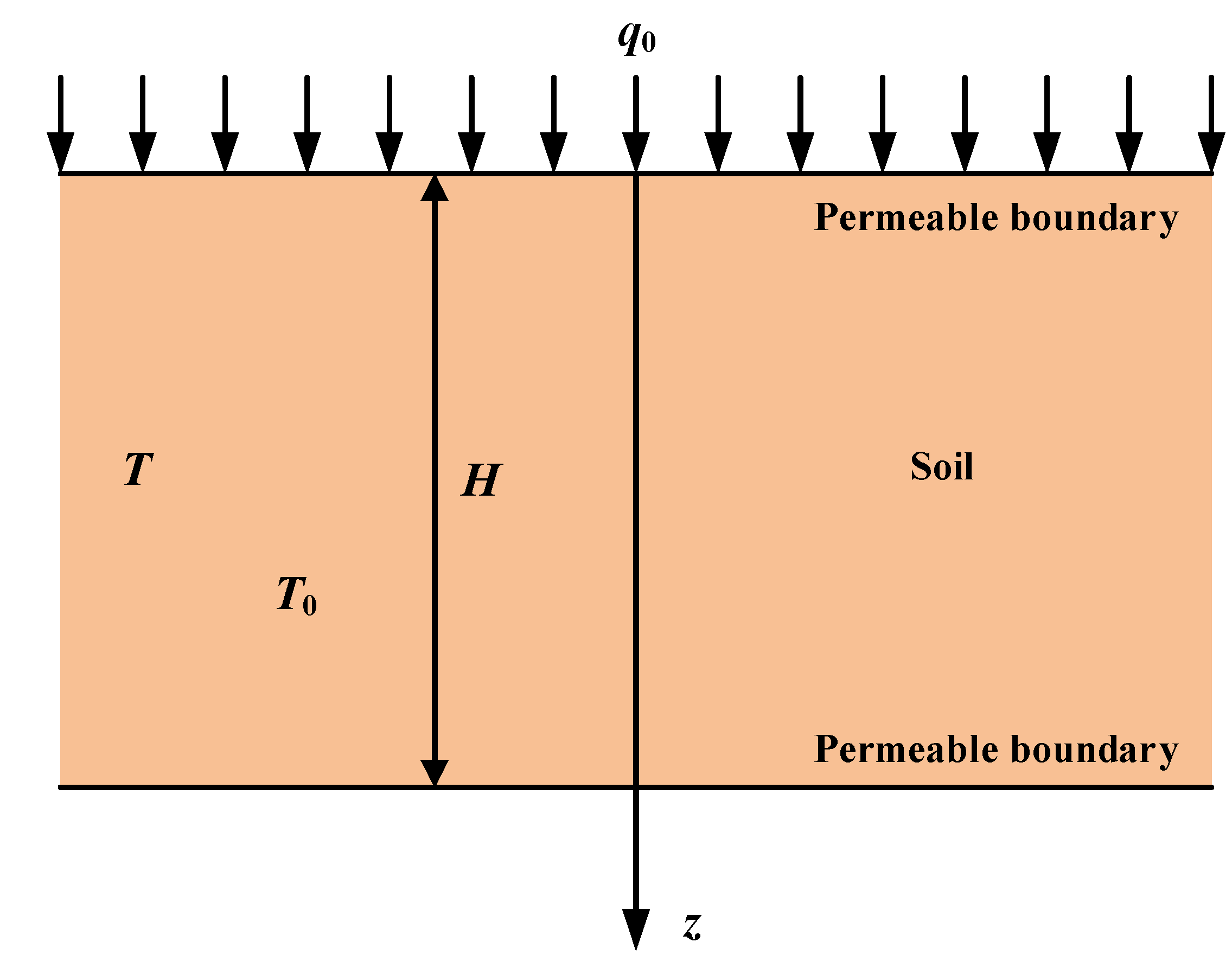
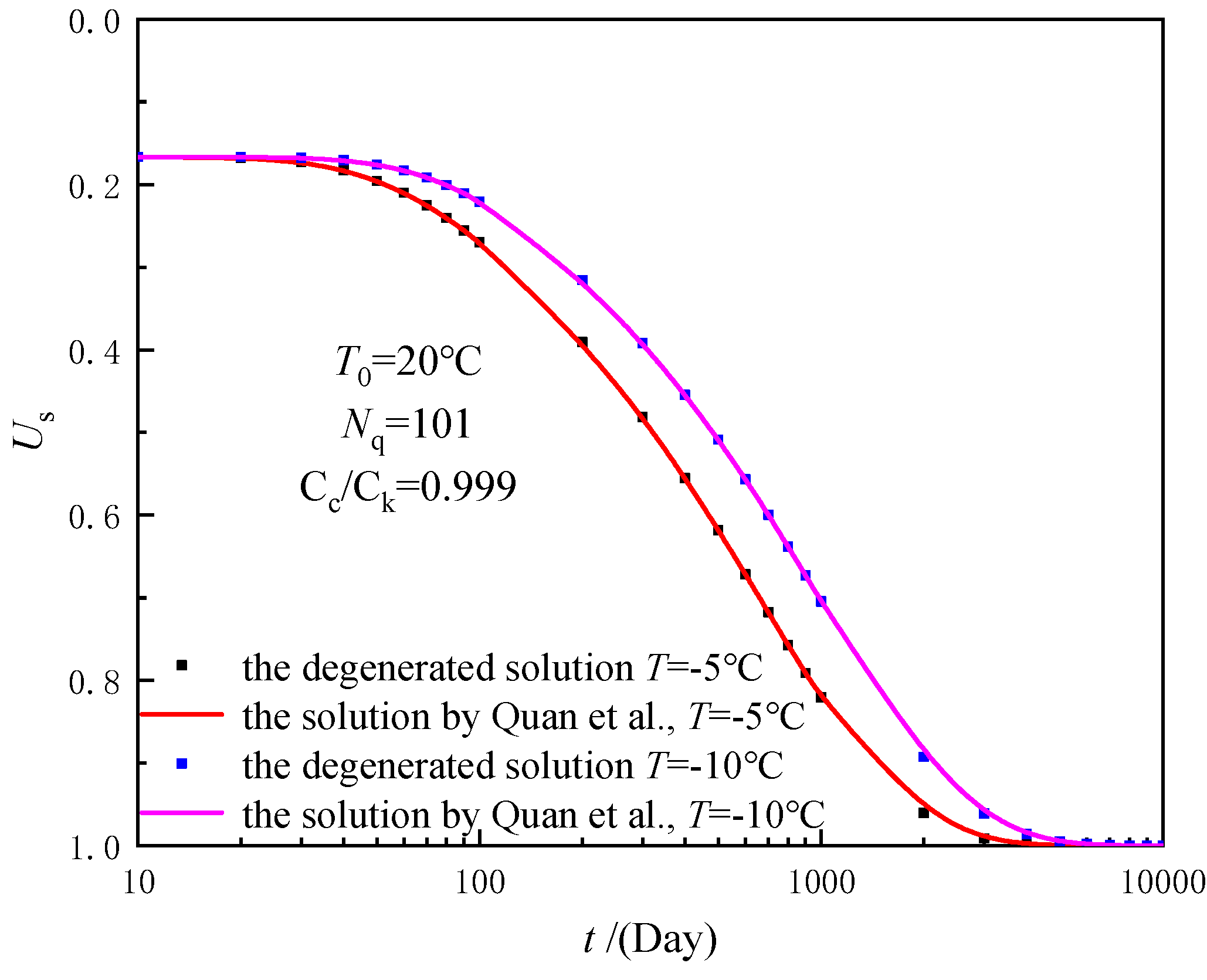
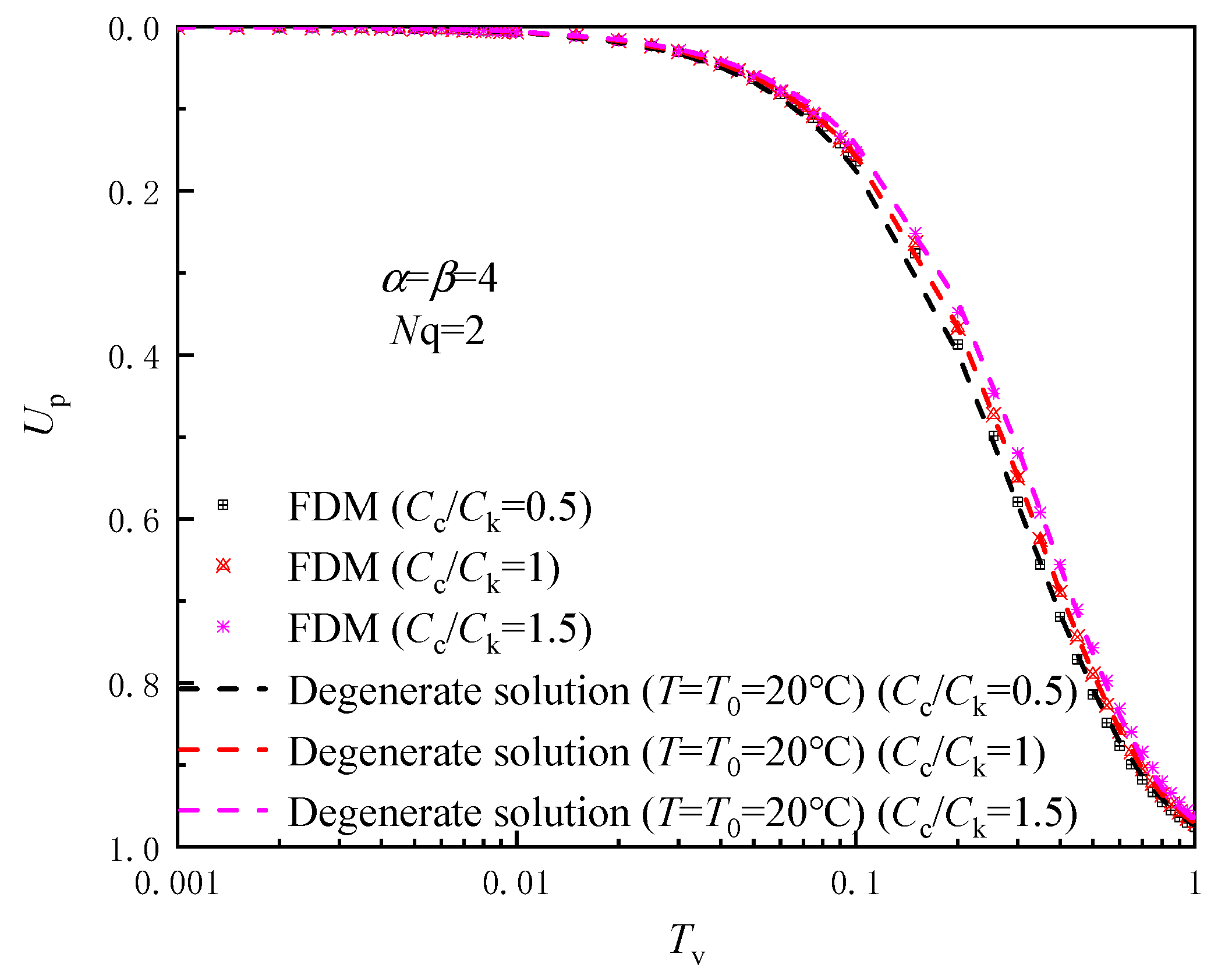

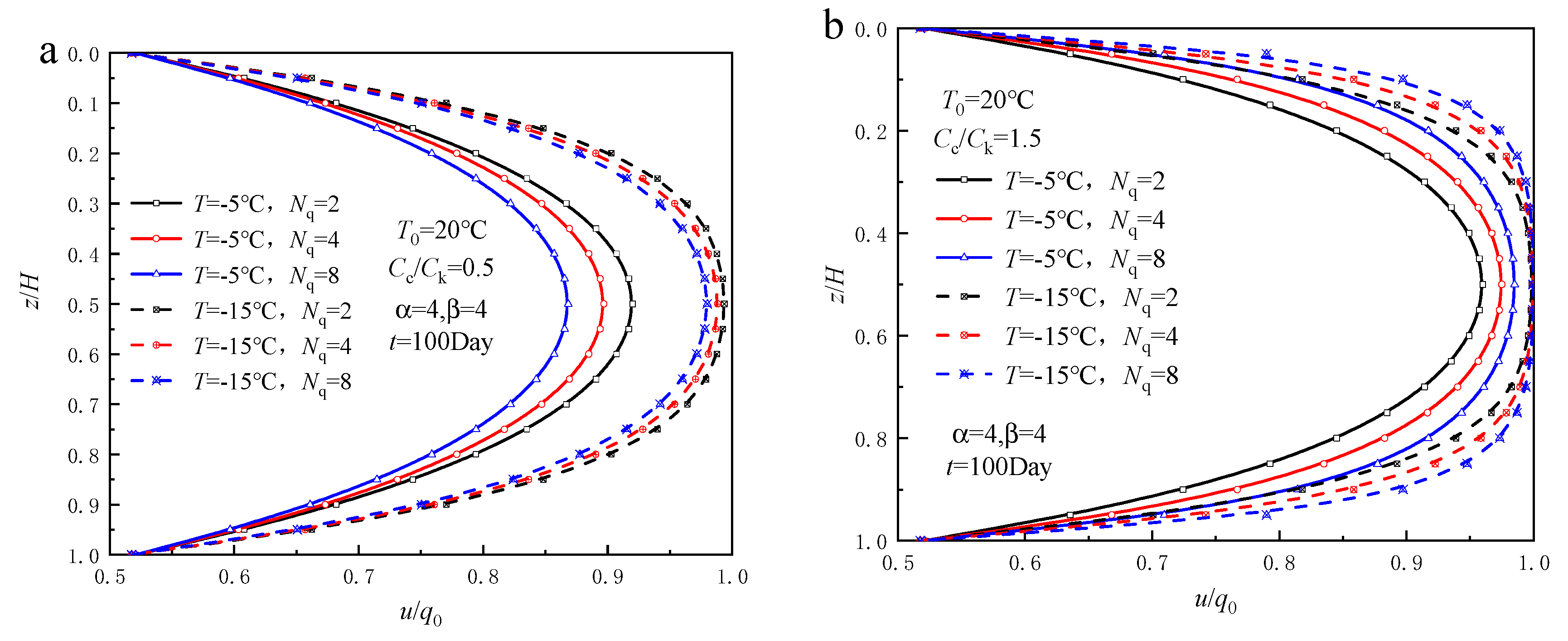
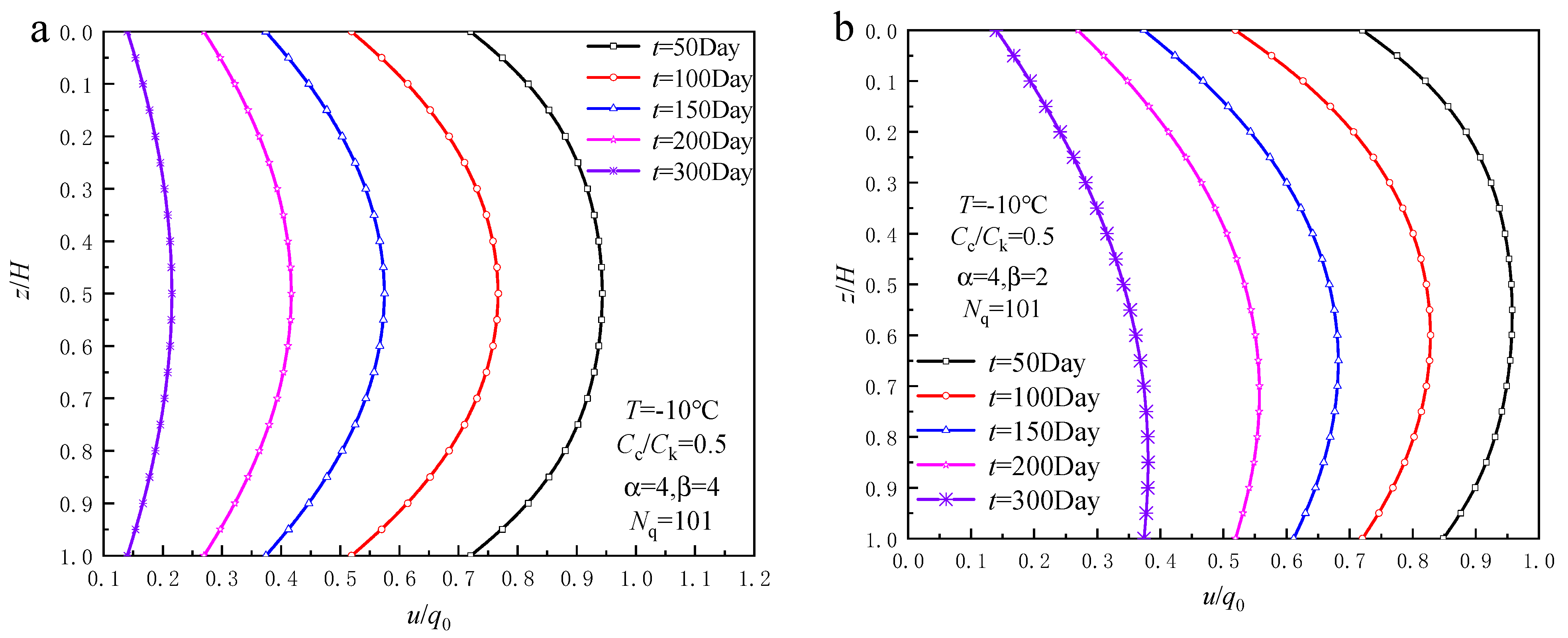
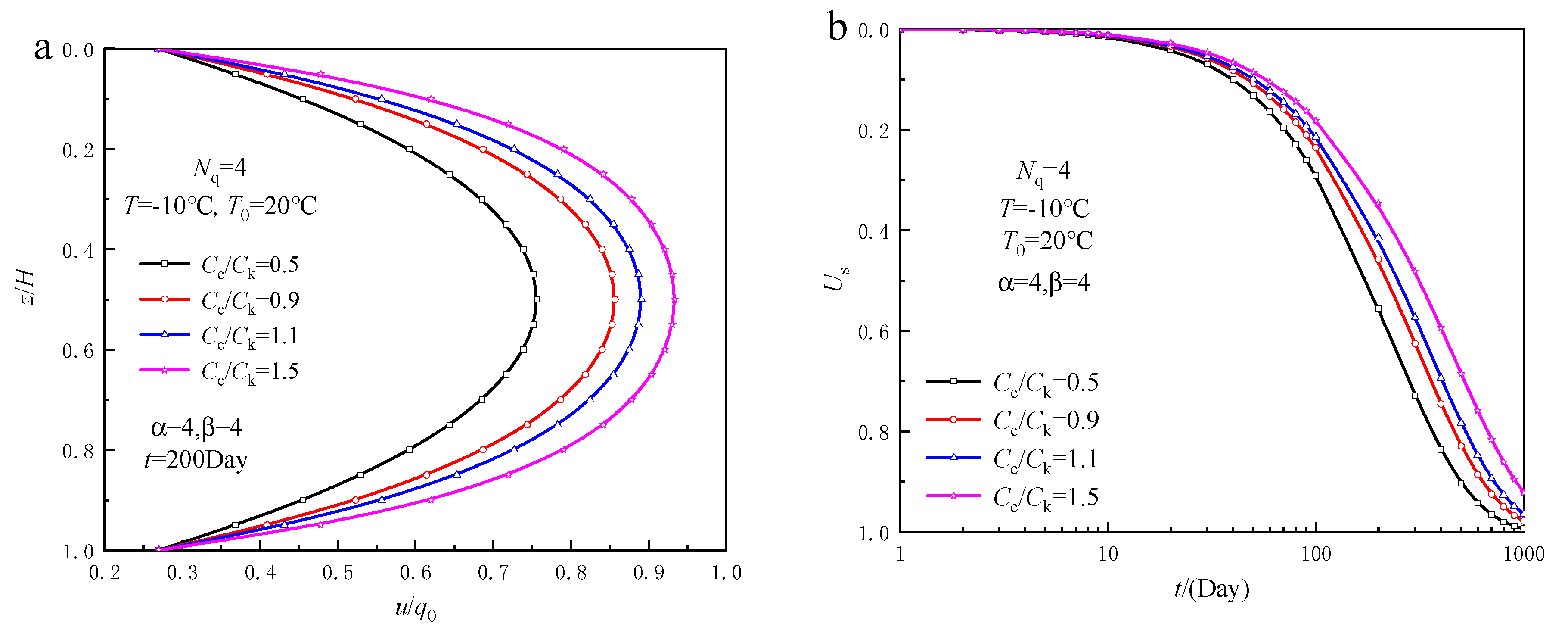

| (m) | ||||||
|---|---|---|---|---|---|---|
| 0.275 | 0.005 | 1 | 10−8 | 1 | 101 | 1.2 |
Publisher’s Note: MDPI stays neutral with regard to jurisdictional claims in published maps and institutional affiliations. |
© 2022 by the authors. Licensee MDPI, Basel, Switzerland. This article is an open access article distributed under the terms and conditions of the Creative Commons Attribution (CC BY) license (https://creativecommons.org/licenses/by/4.0/).
Share and Cite
Wang, Z.; Wu, W.; Zhang, P.; Wang, Z.; Xi, R.; Wen, M. Thermal Effect in Nonlinear One-Dimensional Consolidation of Cold Region Soil. Energies 2022, 15, 5643. https://doi.org/10.3390/en15155643
Wang Z, Wu W, Zhang P, Wang Z, Xi R, Wen M. Thermal Effect in Nonlinear One-Dimensional Consolidation of Cold Region Soil. Energies. 2022; 15(15):5643. https://doi.org/10.3390/en15155643
Chicago/Turabian StyleWang, Zongqin, Wenbing Wu, Peng Zhang, Zuodong Wang, Ruichen Xi, and Minjie Wen. 2022. "Thermal Effect in Nonlinear One-Dimensional Consolidation of Cold Region Soil" Energies 15, no. 15: 5643. https://doi.org/10.3390/en15155643
APA StyleWang, Z., Wu, W., Zhang, P., Wang, Z., Xi, R., & Wen, M. (2022). Thermal Effect in Nonlinear One-Dimensional Consolidation of Cold Region Soil. Energies, 15(15), 5643. https://doi.org/10.3390/en15155643






